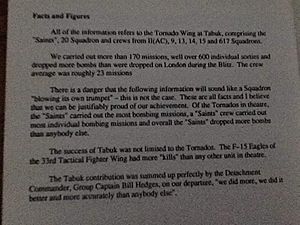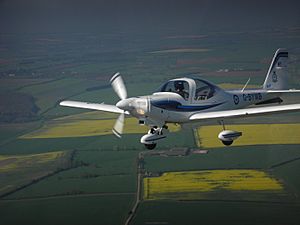No. 16 Squadron RAF facts for kids
Quick facts for kids No. 16 Squadron Royal Air Force |
|
|---|---|
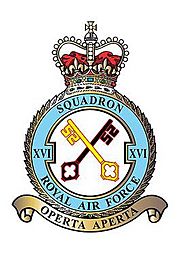
Squadron badge
|
|
| Active | Royal Flying Corps (RFC): 10 February 1915 – 1 April 1918 Royal Air Force (RAF): 1 April 1918 – 31 December 1919 1 April 1924 – 1 June 1957 1 March 1958 – 6 June 1972 8 January 1973 – 29 February 1984 1 March 1984 – 11 September 1991 1 November 1991 – 11 March 2005 1 October 2008 – present |
| Country | |
| Allegiance | King Charles III |
| Branch | |
| Type | Flying squadron |
| Role | Elementary flying training |
| Part of | No. 3 Flying Training School RAF |
| Home station | RAF Wittering |
| Nickname(s) | 'The Saints' |
| Motto(s) | Operta aperta (Latin for 'Hidden things are revealed') |
| Battle honours | * Honours marked with an asterisk may be emblazoned on the Squadron Standard |
| Insignia | |
| Squadron badge heraldry | Two keys in saltire. The badge symbolises army co-operation duties. The keys indicate the unlocking of the enemy's secrets; the gold key by day, the black key by night. Approved by King Edward VIII in November 1936. |
| Squadron roundel | |
| Aircraft flown | |
| Trainer | Grob Tutor T1 |
Number 16 Squadron Royal Air Force, nicknamed 'the Saints', is a flying squadron of the Royal Air Force (RAF) who currently provide elementary flying training (EFT) with the Grob Tutor T1, presently based at RAF Wittering, an RAF airbase in Cambridgeshire, England.
It originally formed as a squadron of the Royal Flying Corps (RFC) on 10 February 1915, at Saint-Omer, France, to carry out a mixture of offensive patrolling and reconnaissance, and was disbanded in 1919 with the end of the First World War. The squadron reformed as part of the recently formed Royal Air Force (RAF) on 1 April 1924, and again took on a reconnaissance role which it continued throughout the Second World War. Post-war, the squadron was disbanded and reformed several times, and was converted to a bomber squadron. Equipped with the Tornado GR1 from 1984, the squadron took part in the Gulf War in 1990. It was again disbanded in September 1991, before reforming in November 1991 as the operational conversion unit (OCU) for the Jaguar. With the Jaguar's imminent withdrawal from service, the squadron disbanded once more in 2005. No. 16 Squadron reformed again and took on its current role on 1 October 2008.
Contents
History
Early years
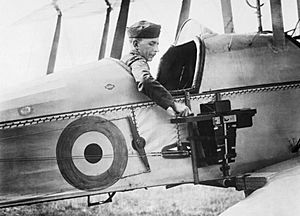
The squadron was formed at Saint-Omer, France on 10 February 1915, from elements of Numbers. 2, 6, and 9 Squadrons. It immediately began fighting in the First World War under Hugh Dowding, and for some time was based at the aerodrome at the Beaupré-sur-la-Lys Abbey in La Gorgue. For the rest of the Great War, the 'Saints' were deployed throughout Northern France and operated a mixture of aircraft including Bleriot XI, Martinsyde S.1 and Royal Aircraft Factory B.E.2c on offensive patrol and tactical reconnaissance duties. Disbandment occurred on New Year's Eve 1919.
In September 1915, Duncan Grinnell-Milne joined the squadron as a junior pilot, and later (1933) published an account of his time in the squadron. His portrait of Dowding (who when the book was originally published had not then attained his later fame) is unflattering.
The squadron was reformed at Old Sarum in Wiltshire in the tactical reconnaissance role on 1 April 1924. Initially, it operated the Bristol Fighter, but this was replaced by the Atlas in January 1931, and by the Audax in December 1933.
Second World War
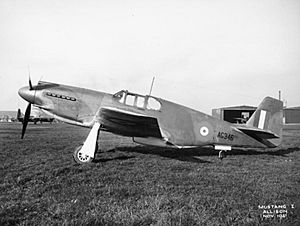
In May 1938, the Westland Lysander arrived, and the Squadron continued in its tactical role in wartime France from April 1940. In May 1940, it returned to England and conducted roving sea patrols searching for both downed aircrew and enemy forces.
From April 1942, 16 Squadron was re-equipped with the Allison-engined North American Mustang I for fighter sweeps and reconnaissance duties over France from its base at RAF Weston Zoyland in Somerset. The Spitfire Mk.V took over this role from September 1943. On 2 June 1943, the Squadron became part of the Strategic Reconnaissance Wing of the 2nd Tactical Air Force (2TAF) as a high-altitude photo reconnaissance unit with Spitfire PR Mk.IXs based at Hartford Bridge. In the build-up to D Day, No 16 supplied photographs instrumental to the planning of the Allied landings.
Cold War (1946–1991)
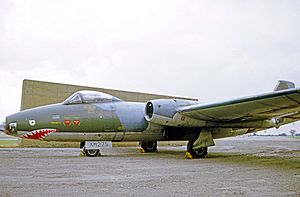
No. 16 Squadron was disbanded at RAF Celle on 1 April 1946 but reformed at RAF Fassberg the same day, and took the 24 cylinder H-engined Hawker Tempest Mk.V on charge, until converting to the radial-engined Mk.II on 7 June 1946. On 7 December 1948, the squadron took delivery of its first jet engined aircraft, the de Havilland Vampire FB.5, which subsequently gave way to the de Havilland Venom FB.1 in November 1954 until disbandment at Celle once more on 1 June 1957.
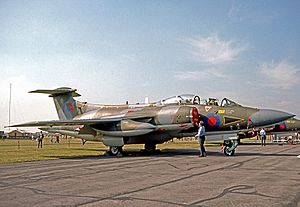
As East-West relations cooled, the Squadron reformed at RAF Laarbruch in West Germany on 1 March 1958. No. 16 Squadron maintained a permanent readiness state, tasked with meeting the Soviet threat, in the expected conventional phase and with the use of tactical nuclear weapons. The squadron was re-quipped with the Canberra B(I).8 armed with the WE.177, a dual-key free-fall nuclear bomb.
The Canberra gave way to the Buccaneer S.2B on 16 October 1972. The squadron's twelve Buccaneers were equipped with a variety of conventional weapons and eighteen British WE.177 nuclear bombs. Although Buccaneers could carry two WE.177 weapons, after taking into account attrition in the conventional phase of a high-intensity European war, and after withholding some aircraft in reserve, RAF planners expected that squadron strength remaining would still be sufficient to deliver the nuclear weapons stockpile. The Buccaneer distinguished itself in many bombing exercises; among its victories included the winning of the Salmond Trophy in 1978 and 1979.
The squadron briefly expanded in 1983-1984, absorbing some aircraft and personnel from its sister 15 Squadron which had converted to the Panavia Tornado GR1. 16 Squadron followed in late 1984 following the 'designate' process where a new 16 Squadron 'formed up' at RAF Honington, before moving to Laarbruch and assuming the squadron standard from the Buccaneer unit which had continued to operate throughout. Despite the change of aircraft, the squadron's role remained unchanged in countering a Soviet threat in Europe with conventional weapons and eighteen WE.177 nuclear bombs. As with the Buccaneer, there was a ratio of 1.5 weapons per aircraft.
Ahead of Operation GRANBY in 1990 and the first Gulf War, the squadron deployed to Tabuk airbase. No. 16 was the lead squadron in the deployment, with No. 20 and crews from other Tornado GR1 squadrons. The 'Tabuk Force' used JP233s and 1,000 pounds (450 kilograms) bombs on low-level sorties against Iraqi airfields and other targets. Some of the Squadron's aircraft later formed a TIALD flight that conducted accurate medium-level bombing.
Following hostilities, the Squadron disbanded on 11 September 1991.
SEPECAT Jaguar (1991–2005)
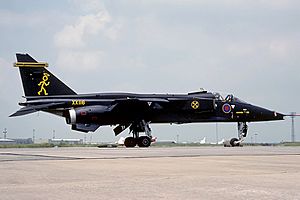
On 1 November 1991, the Squadron reformed at RAF Lossiemouth as No. 16(Reserve) Squadron, a reserve squadron and an operational conversion unit (OCU), replacing and taking over the aircraft and weapons of No. 226 OCU, training and converting new pilots for the SEPECAT Jaguar. Although no longer a front-line operational squadron, as a reserve, or shadow squadron, its twelve aircraft were equipped with conventional weapons and eight WE.177 nuclear weapons for use in a high-intensity European war, and it remained assigned to SACEUR for that purpose.
Although a non-operational squadron, its pilots were still involved in Operation DENY FLIGHT and Operation NORTHERN WATCH. The squadron moved to RAF Coltishall in Norfolk, on 21 July 2000, thus consolidating the RAF's entire Jaguar force at one airbase, joining numbers 6, 41, and 54 squadrons.
In December 2003, the Ministry of Defence (MoD) announced with the Delivering Security in a Changing World defence review, RAF Coltishall would close in 2007, and the recently upgraded Jaguar fleet would be retired early. This led to the disbandment of No. 16 Squadron on 11 March 2005 as the Jaguar approached retirement. The Squadron Standard was laid up in Notre-Dame Cathedral Saint-Omer, France on 20 March 2005.
Elementary flying training (2008–present)
On 1 October 2008, the Squadron was reformed at RAF Cranwell, Lincolnshire, as part of No. 22 Group, operating the Grob Tutor T1. No. 16(R) Squadron continues its training role by instructing new Royal Air Force (RAF) pilots in elementary flying training (EFT) as part of No.1 Elementary Flying Training School (1EFTS). From 2005 to 2008, the unit was previously known as 1 Squadron, 1 EFTS following a restructuring of the RAF's pilot training. 16(R) Squadron instructs the RAF's new pilots along with some pilots from overseas foreign militaries. The Squadrons' role is to provide pilots to the more advanced flying training courses on their way to earning the coveted aircrew brevet, or pilot 'wings', prior to joining a front line squadron or unit. In early 2008, Prince William took his first steps on his aviation career at No. 16 Squadron's site, flying his first solo sortie in Tutor G-BYXN; his father was also taught to fly at RAF Cranwell in 1971.
In the first half of 2015, No. 16(R) Squadron, along with No. 115(R) Squadron relocated to RAF Wittering, Cambridgeshire, which saw flying return to the base for the first time since 2010.
Aircraft operated
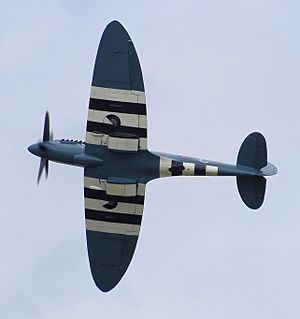
Aircraft operated included:
| date from | date to | manufacturer | aircraft model |
|---|---|---|---|
| February 1915 | March 1915 | Royal Aircraft Factory | R.E.5 |
| February 1915 | March 1915 | Vickers | F.B.5 |
| February 1915 | March 1915 | Blériot | XI |
| February 1915 | May 1915 | Martinsyde | S.1 |
| March 1915 | May 1915 | Voisin | III |
| March 1915 | May 1917 | Royal Aircraft Factory | B.E.2c |
| May 1915 | November 1917 | Farman Aviation Works | S.11 |
| March 1915 | December 1919 | Royal Aircraft Factory | R.E.8 |
| 1924 | 1931 | Bristol Aeroplane Company | F.2 Fighter |
| 1931 | 1934 | Armstrong Whitworth | Atlas |
| 1934 | 1938 | Hawker | Audax |
| 1938 | 1942 | Westland | Lysander |
| 1942 | 1944 | North American Aviation | Mustang |
| 1944 | 1946 | Supermarine | Spitfire Mk.XI |
| 1946 | 1948 | Hawker | Tempest V |
| 1948 | 1948 | Hawker | Tempest II |
| 1948 | 1954 | de Havilland | Vampire FB.5 |
| 1954 | 1957 | de Havilland | Venom FB.1 |
| 1958 | 1972 | English Electric | Canberra B(I).8 |
| 1972 | 1984 | Blackburn | Buccaneer S.2B |
| 1984 | 1991 | Panavia | Tornado GR1 |
| 1991 | 2005 | SEPECAT | Jaguar GR1, GR3, T2, & T4 |
| 2008 | present | Grob | Tutor T1 |
Commanding officers
Commanding officers included:
| date from | date to | rank | name |
|---|---|---|---|
| 8 February 1915 | 23 July 1915 | Major | F V Holt |
| 23 July 1915 | January 1916 | Major | H C T Dowding |
| January 1916 | 5 August 1916 | Major | D W Powell |
| 5 August 1916 | 16 June 1917 | Major | P C Maltby |
| 16 June 1918 | June 1918 | Major | C F A Portal, DSO and Bar, MC |
| June 1918 | 1919 | Major | A W C V Parr |
| 1924 | 1925 | Squadron leader | J O Archer, CBE |
| 1925 | 1928 | Squadron leader | W A Coryton, MVO |
| 1928 | 1931 | Squadron leader | D O Mulholland, AFC |
| 1931 | 1933 | Squadron leader | A R Churchman, DFC |
| 1933 | 1934 | Squadron leader | J R I Scrambler, AFC |
| 1934 | 1936 | Squadron leader | R P Musgrave-Whitman, OBE, MC |
| 1936 | 1938 | Squadron leader | T Humble |
| 1938 | 1939 | Squadron leader | R E S Skelton |
| 1940 | 1940 | Wing commander | T Humble |
| 1940 | 1941 | Wing commander | R C Hancock |
| 1941 | 1942 | Wing commander | P W Stansfeld |
| 1942 | 1942 | Wing commander | A F Pallot |
| 1942 | 1943 | Wing commander | J R Davenport |
| 1943 | 1943 | Wing commander | R I M Bowen, DFC |
| 1943 | 1943 | Squadron leader | Mackie |
| 1943 | 1944 | Squadron leader | E M Goodale, DSO |
| 1944 | 1945 | Squadron leader | A N Davis, DFC |
| 1945 | 1946 | Squadron leader | A S Baker, DFC |
| 1946 | 1948 | Squadron leader | D C Usher, DFC, DFM |
| 1948 | 1948 | Squadron leader | R E Mooney |
| 1948 | 1949 | Squadron leader | L A Malins, DSO, DFC |
| 1949 | 1951 | Squadron leader | L H Lambert, DFC, AFC |
| 1951 | 1952 | Squadron leader | J E J Sing, DFC |
| 1952 | 1952 | Squadron leader | R H Benwell |
| 1952 | 1954 | Squadron leader | R U P De Burgh |
| 1954 | 1956 | Squadron leader | G G G Walkington |
| 1956 | 1956 | Squadron leader | C E Keay |
| 1956 | 1958 | Flight lieutenant | H E Clements |
| 1958 | 1960 | Wing commander | J R Forsythe, DFC |
| 1960 | 1963 | Wing commander | J E Holland, DFC |
| 1963 | 1964 | Wing commander | J V Horwood |
| 1964 | 1966 | Wing commander | A L Bennett |
| 1966 | 1968 | Wing commander | J C Newby |
| 1968 | 1970 | Wing commander | L C Swalwell |
| 1970 | 1973 | Wing commander | K J Appleboom |
| 1973 | 1975 | Wing commander | R A Edwards |
| 1975 | 1977 | Wing commander | W I C Stoker |
| 1977 | 1980 | Wing commander | D Cousins, AFC |
| 1980 | 1983 | Wing commander | P C Norriss, KBE |
| 1983 | 1984 | Wing commander | E R Cox |
| 1984 | 1986 | Wing commander | R H Goodall, AFC |
| 1986 | 1988 | Wing commander | R F R Carr |
| 1988 | 1991 | Wing commander | I Travers Smith, DSO |
| 1991 | 1992 | Wing commander | N C Rusling |
| 1992 | 1995 | Wing commander | J W White, CBE |
| 1995 | 1997 | Wing commander | B W Newby, AFC |
| 1997 | 2000 | Wing commander | A J Sudlow, MBE |
| 2000 | 2002 | Wing commander | P Allan |
| 2002 | 2005 | Wing commander | G Stockill |
| 2008 | 2009 | Squadron leader | I S Smith |
| 2009 | 2013 | Squadron leader | S J Foote |
| 2013 | 2015 | Squadron leader | F C J Parkinson |
| 2015 | 2017 | Squadron leader | C A Melen, CSM |
| 2017 | present | Squadron leader | M Pickles |
Stations
Stations included:
| date from | date to | location | notes |
|---|---|---|---|
| 10 February 1915 | 5 March 1915 | Saint-Omer | initial formation |
| 6 March 1915 | 31 May 1915 | La Gorgue | detachment to Aire Battle of Neuve Chapelle began 10 March 1915 |
| 1 June 1915 | 17 July 1915 | Choques | |
| 18 July 1915 | 11 December 1915 | Merville | Battle of Loos between 25 and 28 September 1915 |
| 12 December 1915 | 30 August 1916 | La Gorgue | |
| 31 August 1916 | 24 May 1917 | Bruay | Battle of the Somme between 1 July and 18 November 1916 |
| 25 May 1917 | 20 October 1918 | Camblain-l'Abbe | |
| 21 October 1918 | 24 October 1918 | La Brayelle | |
| 25 October 1918 | 13 February 1918 | Auchy | |
| 14 February 1918 | 31 December 1918 | Fowlmere | disbanded following cessation of hostilities |
| 1 April 1924 | 16 February 1940 | Old Sarum | reformed as Army co-operation squadron 1938 - first squadron to operate the Lysander |
| 17 February 1940 | 12 April 1940 | Hawkinge | |
| 13 April 1940 | 13 April 1940 | Amiens | |
| 14 April 1940 | 18 May 1940 | Bertangles | Battle of France commenced 10 May 1940 |
| 19 May 1940 | 2 June 1940 | Lympne | Dunkirk evacuation between 26 May and 4 June 1940 |
| 3 June 1940 | 28 June 1940 | Redhill | first RAF squadron to operate there |
| 29 June 1940 | 2 August 1940 | Cambridge | |
| 3 August 1940 | 14 August 1940 | Okehampton | detachment to Cambridge |
| 15 August 1940 | 3 June 1941 | Western Zoyland | Detachments to Okehampton, Roborough, RAF Tilshead, St Just, and Bolt Head. Battle of Britain occurred between 10 July and 31 October 1940. |
| 4 June 1941 | 5 June 1941 | Okehampton | |
| 6 June 1941 | 8 September 1941 | Western Zoyland | detachments to Lee-on-Solent and RAF Tilshead |
| 9 September 1941 | 10 September 1941 | Okehampton | |
| 11 September 1941 | 24 September 1941 | Western Zoyland | |
| 25 September 1941 | 2 October 1941 | Thruxton | |
| 3 October 1941 | 22 November 1941 | Western Zoyland | detachment to Farnborough |
| 23 November 1941 | 26 November 1941 | Lympne | |
| 27 November 1941 | 31 December 1942 | Western Zoyland | detachment to Okehampton |
| 1 January 1943 | 25 February 1943 | Andover | |
| 26 February 1943 | 12 March 1943 | Ford, Wiltshire | |
| 13 March 1943 | 5 April 1943 | Andover | |
| 6 April 1943 | 8 April 1943 | Western Zoyland | |
| 9 April 1943 | 15 May 1943 | Andover | |
| 16 May 1943 | 21 May 1943 | Western Zoyland | |
| 22 May 1943 | 31 May 1943 | Andover | |
| 1 June 1943 | 28 June 1943 | Middle Wallop | |
| 29 June 1943 | 15 April 1944 | Hartford Bridge | operated in Strategic Reconnaissance Wing of the 2nd Tactical Air Force |
| 16 April 1944 | 19 September 1945 | Northolt | D-Day on 6 June 1944, based several ALGs as part of 2TAF. Disbanded following cessation of hostilities. |
| 19 September 1945 | 1 April 1946 | Celle | reformed and disbanded; renumbered from 268 Squadron |
| 1 April 1946 | 31 May 1946 | Fassberg | reformed from 56 Squadron |
| 1 June 1946 | 11 June 1946 | Manston | |
| 12 June 1946 | 20 June 1946 | Fassberg | |
| 21 June 1946 | 13 July 1946 | Sylt | |
| 14 July 1946 | 4 September 1946 | Fassberg | |
| 5 September 1946 | 15 September 1946 | Manston | |
| 16 September 1946 | 3 February 1947 | Fassberg | |
| 4 February 1947 | 20 March 1947 | Gatow | |
| 21 March 1947 | 7 May 1947 | Fassberg | |
| 8 May 1947 | 19 May 1947 | Ahlhorn | |
| 20 May 1947 | 12 July 1947 | Fassberg | |
| 13 July 1947 | 11 August 1947 | Zeltweg | |
| 12 August 1947 | 5 October 1947 | Fassberg | |
| 6 October 1947 | 16 October 1947 | Middle Wallop | |
| 17 October 1947 | 2 November 1947 | Fassberg | |
| 3 November 1947 | 23 November 1947 | Lübeck | |
| 24 November 1947 | 31 November 1947 | Fassberg | |
| 1 December 1947 | 5 January 1948 | Gütersloh | |
| 6 January 1948 | 1 February 1948 | Gatow | |
| 2 February 1948 | 13 July 1948 | Gütersloh | Berlin Airlift begins on 24 June 1948 |
| 14 July 1948 | 6 August 1948 | Lübeck | |
| 7 August 1948 | 1 November 1950 | Gütersloh | Berlin Airlift ends 11 May 1949 |
| 2 November 1950 | 1 June 1957 | Celle | disbanded |
| 1 March 1958 | 6 June 1972 | Laarbruch | Cuban Missile Crisis between 8 and 28 October 1962 |
| 8 January 1973 | 29 February 1984 | Laarbruch | |
| 1 Mar 1984 | 11 Sep 1991 | Laarbruch | squadron took part in Operation GRANBY |
| 1 November 1991 | 20 July 2000 | Lossiemouth | became a Reserve squadron as Jaguar OCU |
| 21 July 2000 | 11 March 2005 | Coltishall | Coltishall, the last surviving operational RAF base involved in the Battle of Britain, closed on 30 November 2006 |
| 1 October 2008 | 16 May 2015 | Cranwell | elementary flying training |
| 16 May 2015 | present | Wittering | elementary flying training |
See also
- List of Royal Air Force aircraft squadrons


